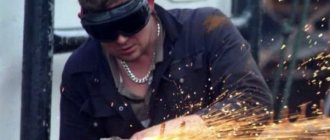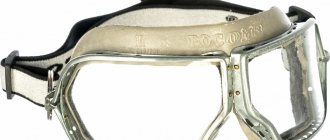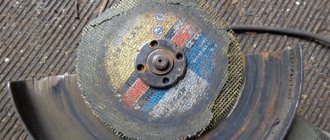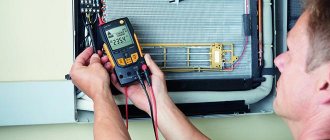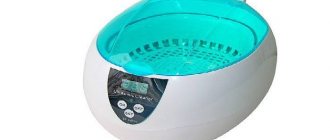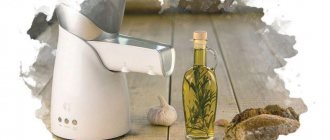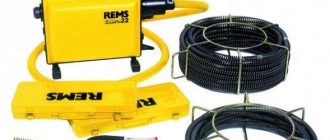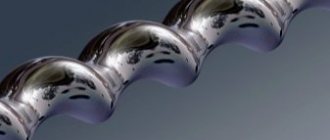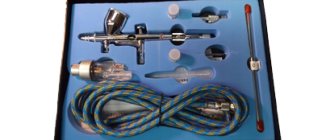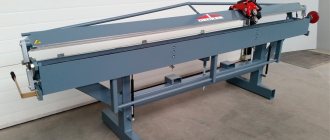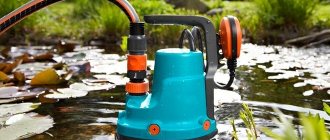Structure and capabilities of the grinder
An electric angle grinder is used for grinding, polishing and cleaning surfaces, welds and edges. The technique is effective in cutting various materials and making products from metals, stones, bricks and concrete. The development of artificial diamond technology has made it possible to turn the grinder into a universal cutting machine. Now the quality of their execution is regulated by GOST R IEC60745-2-3-2011 and is tested in laboratories.
Grinder grip
In general, the device in an angle grinder is as follows:
- The rotation of the motor rotor is ensured by an electric motor with a control unit and a current supply cable.
- A gear and a fan are installed on the shaft. The mechanism is engaged with a driven gear mounted on the drive spindle. The latter rotates the working tool - a disk or stone.
According to their design, there are one- and two-handed grinders:
- One-handed tools. There is no main handle, they weigh up to 2.5 kg, the diameter of the circle is 100, 115 and 125 mm.
- Two-handed instruments. There are main and additional handles, the diameter of the circle ranges from 125 to 230 mm, the weight of the machines is 2.5-6 kg.
Rules for cutting tiles and porcelain stoneware
We asked a specialist how to properly cut tiles and porcelain stoneware with a grinder. There are two options.
- Using an abrasive wheel for stone (usually these wheels are marked accordingly), and the abrasive is silicon carbide grains, which have a less aggressive shape than electrocorundum, which is used for cutting ferrous metals. The powder of this abrasive is mixed with a binder bakelite resin and a circle is formed from this mixture using one or several layers of fiberglass mesh, which plays a reinforcing role.
- Diamond wheels, where the cutting elements are grains of industrial diamond, and the binder is cobalt.
Preparing to work with an angle grinder
The rules for working with power tools and their accessories always provide for preparatory work. Bulgarian is no exception. First of all, you should prepare the required protective equipment.
Safety precautions when working on a lathe
Note! The minimum program is glasses and a casing. Failure to comply with these requirements may result in sparks entering the eyes and injury.
You should also have protective gloves. During the labor process, the hands are close to the disk. This causes particles, scale and sparks to land on your fingers and palms. Thick gloves are used to protect hands and preserve their skin. This is a minimal set for home use. If we are talking about production, then in the work area you need full protective clothing that covers all parts of the body.
Rules and algorithm for using the tool
Cutting metal with a grinder To ensure that the work performed using a grinder is of high quality and not hazardous to human health, it is important to pay attention to the following operating rules:
- The cutting disc is installed with the equipment turned off from the network. Visually inspect it for damage and uneven edges. It is a priority to use a new disk before each use.
- The grinder is held with both hands, and the diameter of the grinding wheel should not exceed the size provided by the grinder itself.
- The protective cover, which prevents splinters and shavings from falling on a person, should always be located on the worker’s side. If for some reason this part is missing, the grinder cannot be used due to the high risk of damage to uncovered parts of the body.
- Before starting the main work, the tool must be checked at idle speed. If the blade is installed correctly and there are no problems, you can begin sanding or cutting.
- The power cable should always be behind the worker’s back, but not near or under his feet. The shavings can damage its integrity, and constant movements of the legs do not exclude confusion and loss of balance.
- It is strictly forbidden to install disks intended for a circular saw on an angle grinder. This can not only lead to damage to the instrument, but also increases the risk of injury.
- Work with an angle grinder can only be carried out in special protective clothing and glasses that prevent small chips from getting on the skin and mucous membranes.
- All work must be performed away from flammable objects and surfaces. Sparks generated during the cutting process can cause a fire.
You need to understand that the features of the operation and operation of the tool completely depend on what kind of material we are talking about.
How to work with a grinder for metal?
Metal cutting is carried out using special discs designed for this purpose. It is not recommended to press hard on the tool. Under the influence of its own weight, the cutting process occurs quite quickly.
When working with metal, it is important to control the angle of the angle grinder. The safest option is to position the disk relative to the metal plane at an angle of 90°
Failure to follow this recommendation leads to significant overheating of the tool and also increases the risk of chipping on the disc itself.
If you plan to perform grinding and troweling work, the angle can be changed spontaneously by moving the grinder in one direction. A prerequisite is the correct direction of rotation of the disk. It should always rotate in the direction of the user. Even if there is a breakdown and it is chewed by an angle grinder, the tool will fall on the floor and not on a person.
Working with wood
Due to high speeds, an angle grinder with a specially selected grinding wheel performs cleaning work tens of times faster than a conventional grinding machine.
It is only important to use disks correctly, without saving on them
High disk rotation speed also has negative qualities. A huge amount of fine wood dust is formed, which easily settles on the mucous membranes. Therefore, you should additionally take care of a respirator and safety glasses. When used in industrial enterprises, such workshops are equipped with a special dust extraction system.
When processing cross sections of wood, it is extremely important to control the speed and perform work at minimum speed. If this is not followed, there is a possibility of burning the wood, which will lead to loss of presentation.
Polishing discs, which are used in special grinders, cannot be used in grinders. Since at high speeds such discs can simply shatter into small fragments, the risk of injury increases several times.
The wood must be sanded in one direction. It is not recommended to put too much pressure on the grinder and use it for a long time in one area. The sanding disc is held strictly parallel to the surface of the wood.
Tiles and porcelain tiles
In order to cut a tile or a section of porcelain stoneware correctly and without defects, it is necessary to use a special abrasive wheel for stone made of large particles of silicon carbide. Diamond wheels are suitable for working with stone and its varieties. The thinner the material being processed, the larger the circle should be in diameter.
The work involves fixing the material being processed in special planks. This eliminates the possibility of unwanted chips and damage. The tilt angle is controlled independently.
Features of working with an angle grinder
Safety precautions when working on a drilling machine
A modern angle grinder allows you to replace the emery when working on metal. To avoid problems, it is useful to remember a few guidelines when using the tool:
- The angle grinder should be held with both hands during operation. In the event of a kickback, a strong fixation will minimize displacement. Otherwise, the risk of injury increases.
- Work should be carried out on a flat surface, confidently maintaining balance.
- Place the power cord on the opposite side of the disk. The operating instructions for the angle grinder make these requirements in order to avoid short circuits and shock waves from the unit.
- When completing work, the tool should be held firmly in your hands until the disk comes to a complete stop.
- If there is a power outage, you must unplug the tool from the outlet. Otherwise, the angle grinder may start working without operator control.
- The work process is accompanied by heating of the disks. After turning off the tool, they should not be touched until they cool down.
Fixing the material
The principle of woodworking
The angle grinder was originally designed for polishing and sanding surfaces, and therefore it can easily cope with operations on wooden workpieces. At the same time, there are some nuances and rules of work that will not only protect the craftsman, but will also help him better cope with wood processing.
First, you should dwell on the types of nozzles, among which are:
- Sanding pads are a multi-layer compound disc where rubber and plastic alternate with foam rubber, sandpaper or wool flannel. The structure helps to extend the life of the wheel and polish the surface.
- Flap discs are designed for rough processing of wood at the initial stage. Sandpaper petals of different grain sizes are attached to the surface of the circle, which polish the surface, removing all imperfections.
- A wire brush is used to remove old paint from a wooden surface.
Operations involving polishing or sanding wood are considered relatively safe. During operation, the disc does not get stuck in the cut, there are no jerks, short circuits or deformations of the wheel.
Wood cutting
Only one type of cutting wheel is used to cut wood material. With its side teeth it resembles a circular saw blade, but they are not so long. The teeth help cut deeper into the material, but you need to cut the boards carefully, as the grinder may jerk. Boards about 40 mm thick are sawn off.
The use of circular discs instead of cutting wheels is strictly prohibited, because they are designed to operate at 3 thousand rpm. The grinder does not produce even half this speed. Accordingly, circular circles are deformed at best. The use of circular wheels can cause serious injury.
Instructions and recommendations for cutting with a grinder
Working with materials is characterized by one sentence: the directions of tool movement and disk rotation must coincide.
Safety precautions when working with disinfectants
Note! It is necessary to come into contact with the surface being cut at maximum spindle speed - otherwise jamming may occur.
Wherein:
- The cutting line should pass by the working person, and not rest against him. If the disc jams, the reactive movement of the tool will pass by the operator.
- Start cutting profiles from the place with the smallest cross-section.
- The protective cover provides safety only if it is between the person and the circle.
- When cutting walls, a cable, fittings or pipe may get caught, which will lead to a kickback. Be away from the possible displacement line.
Polishing ceramic tiles
In the construction industry, the grinder occupies a leading place among tools. Using special discs and attachments, ceramic products are cut and polished, preparing them for installation. A diamond-coated grinder requires special consumables, because cutting ceramics with a regular cutting wheel will lead to breakage or cracks in the tiles.
Dry cutting discs for tiles are divided into
segmented and solid .
Both types do not require constant cooling - which is why they got their name. Solid discs are cooled only after 1-2 minutes of operation by lowering the circle into cold water . The segmented type cools itself due to the slots , but they are not always suitable for cutting ceramic tiles due to the formation of chips on the surface of the material. A segmented or solid disc processes ceramic material and any natural stone . Sometimes, with high-quality work, it is possible to cut paving slabs with a household grinder without deformation or process the edge part of the cut.
Straight line cutting
Unlike cutting wood, ceramic is a brittle and demanding material that easily deforms under high loads. Therefore, the discs are pre-selected depending on the density of the stone. The speed must be higher than when processing low density materials.
It is most effective to cut ceramic tiles using circles with a diameter of 115 mm at a speed of about 6-8 thousand revolutions per minute. Not every household grinder produces such power, so you will have to find a tool with the necessary characteristics.
The procedure for working with the material is divided into several stages:
- The tiles are laid on a flat surface with a clamp attached and marked in the cutting area.
- Cutting begins gradually along the surface of the entire tile. First you need to make a rut with a depth of 1-1.5 mm, gradually increasing it.
- Move the grinder evenly and slowly while cutting. You cannot put pressure on the unit, because it itself goes deeper into the tile under its own weight.
- There is no point in completely cutting the material. Most often, they place a nail under the tile and simply press it to break it.
Rules for grinding with an angle grinder
Briefly about the main thing:
- Thin circles should not be used.
- Do not grind with the side surface of the cutting disc - it is not designed for such work.
- The circles are not designed to exert significant lateral force - they may break.
- Grinding is carried out with the edge of the disc at an angle of 15-40 degrees relative to the plane being processed.
- If wood (or a product made from it, for example, a cabinet) is sanded, then an angle grinder is used to make the material smooth, removing paint and a thin layer from the surface.
- Instead of discs, a sanding drum is often used.
Operations that can be performed using an angle grinder
The grinder is a multifunctional tool. The drive mechanism in it is an electric motor, which through a gearbox transmits movement to a shaft with a replaceable attachment attached to it. The general view of the device is shown in the photo below.
There are models on the market that differ in power and design:
household;
Angle grinder (grinder) FT-1318
professional;
Professional large angle grinder 230mm Stern AG230B
with or without handles.
Powerful devices are powered by a three-phase voltage of 380 V, and household devices are powered by a single-phase 220 V network. Low-power battery models are also available.
An angle grinder (angle grinder) can do the following main types of work with various materials:
- cutting;
- grinding;
- polishing.
The angle grinder is designed to work with the following materials:
- concrete;
- metal;
- tree;
- glass;
- ceramic tiles;
- stone;
- brick;
- plastic.
Grinders have become widespread both in everyday life and in industrial settings. This is due to their wide functionality, due to the following factors:
- a large selection of different attachments from different materials to perform various operations;
- Possibility of fixed fixation using special fastening devices;
- the presence in some models of additional handles and several speed modes of operation.
At the same time, you must always remember that only special discs are used to process each material.
What is a kickback?
This is the name of one of the most dangerous cases that can happen during work. The effect occurs when the wheel is strongly jammed into the workpiece, as a result of which the power tool is sharply thrown back. It is necessary to carefully monitor the process and hold the grinder tightly.
The points weren't enough
How to avoid kickback
To do this you need:
- Always hold the tool by the standard handles.
- Take a stable position on the ground.
- Use both hands.
- Be slightly away from where the tool will hit.
- When the angle grinder moves away from itself during a reverse impact, it bounces onto the person.
- Be especially careful when working around corners and edges.
General instructions on safe work
Mandatory for all personnel whose work involves the use of electrical equipment:
- Before starting the machine, the operator should check the stability of the mechanism. Remove interfering objects, tighten the legs if it is floor-standing. Portable devices should be located within a comfortable area - in front of the body and above the elbow.
- When several operators work together, each is responsible for his own area and actions must be coordinated.
- Installation, replacement of attachments and other actions are performed after turning off the device from the network. Any movement of parts of a working mechanism is prohibited.
- You can turn on the equipment when it is installed correctly.
- It is prohibited to entrust the device to other persons who do not have the appropriate knowledge and experience.
- Drilling, sawing, and soldering are prohibited inside enclosed spaces where communication networks are laid.
- The equipment cannot be disassembled/assembled or repaired if it is turned on.
- It is prohibited to remove waste chips and small trimmings from under the moving parts of the device when it is turned on. You need to turn off the power, then wait until the operation stops.
- Do not touch moving parts of the equipment with your hands or foreign objects.
- When working, you must be positioned out of reach of machine parts. In case it breaks, so that flying parts do not hit people. This applies to dangerous cutting, piercing, heavy and drilling parts.
- The operator must not drink alcohol or take any drugs before work.
Note! This list of instructions helps to maintain the safety of yourself and other employees.
Safety precautions when operating an angle grinder
Note! It is no secret that when interacting with a dangerous tool, there is always an instruction consisting of rules that allow you to avoid unpleasant consequences when working with an angle grinder.
The following points should be emphasized:
- Compliance with requirements and instructions.
- Do not work with a damaged disk.
- Use the wheel according to its intended purpose: cutting wheel for cutting, grinding wheel for processing.
- A good master is careful, attentive and calm.
- Monitor the situation both before and after the operation.
- When using an angle grinder, do not stretch
Device Features
The simple design of an angle grinder does not prevent it from being one of the most popular and necessary tools in the household. The principle of operation is an electric motor that drives the shaft through an angular gearbox, onto which a special disk is attached.
The main advantage of this technique is its versatility, because when using various discs, cutting, polishing or grinding off excess material is performed. There are discs designed for working with wood, but they cannot be used for metal. Discs with an abrasive base of different grain sizes are used as polishing consumables.
Bulgarians are classified into several types:
- Professional;
- Low, medium and high power;
- Without handles;
- Household;
- With one or two handles.
Low-power equipment is powered from a simple household socket of 220 V, but powerful angle grinders are connected to a network with a voltage of 380 V. Regardless of the power, all machines perform manipulations such as cutting, grinding and polishing wooden, concrete, metal and plastic materials.
The only difference is the operating time. Powerful equipment can work longer without overheating, but household equipment must be given a rest. If necessary, an angle grinder serves as the basis for creating a small machine. To do this, the grinder is fixed permanently and parts, drills, cutters are turned and knives are sharpened.
The grinder is an indispensable equipment for construction and rescue work in auto repair shops and economic activities.
There are several reasons why an angle grinder is classified as a dangerous tool:
- Working with an angle grinder often takes place on an unstable surface, where it is impossible to find support for a stable position.
- Although protected, most of the rotating disk is not protected.
- Abrasive polishing discs often break during operation into medium and small pieces, which fly off in different directions at great speed.
How not to work with a dangerous tool
Don't hesitate to do the following:
- There is no need to apply pressure to the grinder. The tool copes with its tasks under its own weight, while overload only leads to misalignment of the disk.
- Do not turn on the angle grinder if the angle grinder is in the cut of the material.
- When using an angle grinder, do not stretch forward or crawl under yourself in an effort to cut off as much as possible.
- Do not operate a tool in an inadequate or unhealthy condition.
- There is no need to hold the workpieces and materials with your body weight (for example, with your foot) - they should be secured mechanically.
Types of grinders
According to their functional purpose, grinders are:
- Household - intended for home use, have a minimum set of functions.
- Semi-professional – have additional functions that increase the scope of application of the tool.
- Professional – equipped with additional components and suitable for professional installation and construction work.
When choosing a tool, it is important to pay attention to the following technical characteristics:
- Disc rotation speed (revolutions per minute) - the smaller the disc, the more revolutions it makes. The indicator depends on the type of work performed.
- Motor power – low-power models are used for cutting and grinding, while for dense materials you need to choose only models with a power of more than 2 kW/h.
- The presence of additional functions, clamps, and protection determines the level of comfort when using the tool during long-term use.
Depending on the number of handles, grinders come in two types:
- One-handed - light weight and mobile. Power up to 1.5 kW/h. Used primarily for grinding and cutting work.
- Two-handed - an additional handle helps to hold a more powerful and heavier structure, adjusting the pressure when working.
As for manufacturers, domestic brands, which are much cheaper than their foreign counterparts, may be suitable for household use. If you plan to purchase professional equipment, then the priority is brands such as Makita, Bosch, Hitachi.
Precautionary measures
Safety precautions when working with an angle grinder require compliance with the following points:
- The workpiece must be well secured.
- Always watch where sparks will fly during work and avoid potential fire situations.
- Before work, check the protective casing.
- Make sure that the disk that will be used for work is not damaged.
Sparks are also dangerous
Following these simple measures will avoid the vast majority of possible problems. And using all the labor safety instructions when working with an angle grinder (grinder) will minimize the likelihood of unpleasant incidents, preserving health and life.
Before work
Before proceeding to direct work with the tool, you should make some preliminary preparations:
- You should not work with any power tool (not only with an angle grinder) if you are unhealthy, tired or intoxicated - loss of clear control over the body leads to negligence in actions, lack of the required reaction speed and uncoordination of movements. Mandatory components for safe work with an angle grinder are closed safety glasses (preferably reinforced) for reliable protection of the organs of vision from sparks or scale flying along an unpredictable trajectory, as well as a protective casing that guarantees that no fragments of the material being processed or sparks enter the worker.
